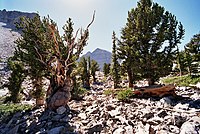
Photo from wikipedia
The correlations of phenotypic traits with environmental drivers suggest that variability of these traits is a result of natural selection, especially if such trait correlations are based on genetic variability.… Click to show full abstract
The correlations of phenotypic traits with environmental drivers suggest that variability of these traits is a result of natural selection, especially if such trait correlations are based on genetic variability. We hypothesized that in situ correlations of structural needle traits of Scots pine (Pinus sylvestris L) with minimal winter temperature (Tmin) reported previously from a temperate/boreal transect would be conserved when plants are cultivated under common conditions. We tested this hypothesis by analyzing needles from two common gardens located in the temperate zone, one including adult trees and the other juvenile seedlings. The majority of adult needle traits for which correlations with Tmin were found in the field turned out to be under environmental influence. In contrast, the majority of traits studied in juvenile needles were correlated with the original Tmin suggesting the role of past natural selection in shaping their variability. Juvenile needles thus appeared to be inherently less plastic than adult needles, perhaps reflecting the stronger selective pressure acting during juvenile, as compared with adult, ontogenetic stage. Genetically based cold-climate adaptation in either juvenile or adult needles, or both, involved an increase in leaf mass per area and leaf density, decrease in needle length, reduction in the amount of xylem and phloem, increase in thickness of epidermis, decrease in tracheid diameter and increase in tracheid density, and increase in diameter and volume fraction of resin ducts. We also show that at least some traits, such as transverse xylem and phloem areas and number of fibers, scale with needle length, suggesting that climate-related trait variation may also be mediated by changes in needle length. Moreover, slopes of these allometric relationships may themselves be plastically modified. The phenotypic syndrome typical of needles from cold environments may thus be under environmental, genetic and allometric control.
Journal Title: Tree physiology
Year Published: 2019
Link to full text (if available)
Share on Social Media: Sign Up to like & get
recommendations!